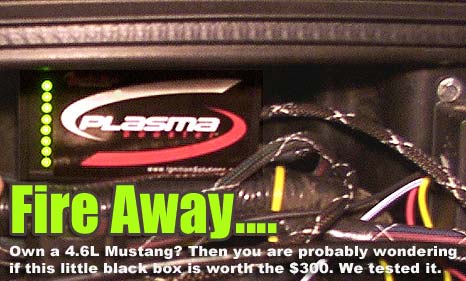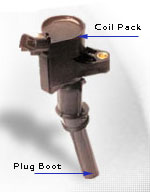
If you've been hot rodding cars
for a while then ignition systems probably don't impress
you. Like most, you buy that familiar rectangular red
box because you know if you don't you'll always wonder
if your engine could be making a little more power, running
a tad better, etc. But the fact is, you really don't gain
what you think you should for the money you spend on fancy
capacitive discharge boxes, billet distributors, hot coils,
etc.
So chances are pretty good that if a buddy told you he
wanted to shell out $300 on a spark box to shave that
extra tenth of a second off his ET, you'd direct him away
to something a little more predictable. But what if that
buddy owned a a new Mustang with a modular motor? Perhaps
the rules don't apply... or perhaps we don't even know
the rules!
Much of the modular motor crowd is as new to the game
as the modular motor itself. Ford began using the 4.6L
V8 powerplants beginning in 1996. While a lot of the same
principles of hopping up the venerable 5.0L pushrod motor
still apply, a good deal had to be developed, tried and
tested.
One such modification generating a good deal of controversy
is a little black box called the Plasma Booster, made
by Ignition Solutions. Some are reporting as much as 10hp
and 15lb/ft on the single overhead cam, 4.6 liter V8 Mustang
GT. So we decided to obtain one of these units and test
it ourselves. Our first reaction was typical of a pushrod
and carb veteran "nah, its just a multispark box."
But visit any of the handful of modular motor web sites
and forums and there are plenty of people claiming otherwise.
The Idea
The Plasma Booster sets up a capacitance/inductance feedback
circuit between the spark plug and ground that will cause
the spark to fire

Coil-on-Plug (COP) ignition
systems are already better in delivering more spark
energy to the combustion chamber (nearly 25% more
voltage.) This is because
the coils have more time between each firing, increasing
the "coil saturation" time (the time the
voltage to the coil is on to build up its magnetic
field.) The lack of plug wires also means direct
voltage transfer from the coil to the electrode. |
multiple times after the initial
spark. The longer duration spark is said to improve the
combustion event, burning the fuel/air mixture more completely.
This, in theory, should release more energy in the form
of increased torque.
While this is not a completely new idea, this is the first
system we have seen that is intended for coil-on-plug
(COP) ignitions. Ford stopped using a distributor and
single coil to fire the spark plugs with the advent of
the modular 4.6 liter V8 and went to an individual coil-on-plug
setup in 1999. This gives the EEC complete control over
all timing events. This also gives each coil a longer
time to recover between sparks.
Installation
The Plasma Booster is very simple to install. It's wise
to disconnect the battery when performing any electrical
work. (We're not saying we were wise.) Simply use the
supplied connectors to tap into the hot lead on each coil.
Secure the ground and find a place to mount the roughly
5" x 3" box. We located it right on the firewall,
below the cowl seam, on our test 2001 GT. The kit includes
double sided tape to secure the box - no additional drilling
required, a nice change from the struggles of mounting
typical spark boxes.
Once in place, turn the ignition to "on" and
confirm all eight LED’s on the unit light-up green.
This indicates each coil lead is properly connected. Then
fire up the motor. Our test car fired up and settled to
an idle without a glitch. A quick test ride and the owner
reported a noticeable power gain on his SOP (seat-of-the-pants)
meter. Time to get some objective results.
Testing
Rather than report just the best numbers, as you may
find in some magazines, we'll walk you through our testing
procedure even if it means admitting some initial flaws.
Our 2001 Mustang GT test vehicle had run a previous
best of 13.08 @ 103.8 (see side bar for mods.) The obvious
goal would be to see a better ET and mph with the Plasma
Booster. Our initial plan was to get some back to back,
with and without, same-day track results. Because track
and environmental conditions can vary, we needed to
establish a sameday baseline ET without the Plasma Booster,
then connect it and note any differences.
We installed the black box on a Friday evening, and
went straight to the track on Saturday morning. We had
Mark, the owner, make several runs and then we had Drew,
a local hotshoe with a reputation for being able to
drive other peoples cars faster than they can, make
a few runs to rule out "operator error." Drew
also holds the current best-to-date for Marks car, a
13.08 @ 103.8. So it made sense to have him participate
in this testing.
Unfortunately our drivers got caught up in gunning for
the 12's and didn't stick to a "scientific"
test plan. Only one run was made without the Plasma
Booster, and the rest were made with it installed. We
also neglected to obtain the ET Streets used to achieve
the cars previous best, so we resorted to Nitto drag
radials. Clearly not enough consistency to establish
meaningful results. Nevertheless Drew would record a
104.60 mph trap speed, nearly one mile per hour higher
than the previously recorded best. Without the Plasma
Booster, the same driver managed a 102.25 mph, but the
60ft was significantly better, making the results, in
our eyes, invalid. (It is common to see the trap speed
come down with a better sixty-foot.)
So while the mph difference looked very promising, the
lack of methodical testing forced us to disregard these
results and schedule for more track time. We also decided
that the differences were probably going to be numerically
small enough where it would beg the question if the
improvements weren't simply due to environmental factors.
As a results we decided we had to get the car on a dyno
to get objective data.
|

